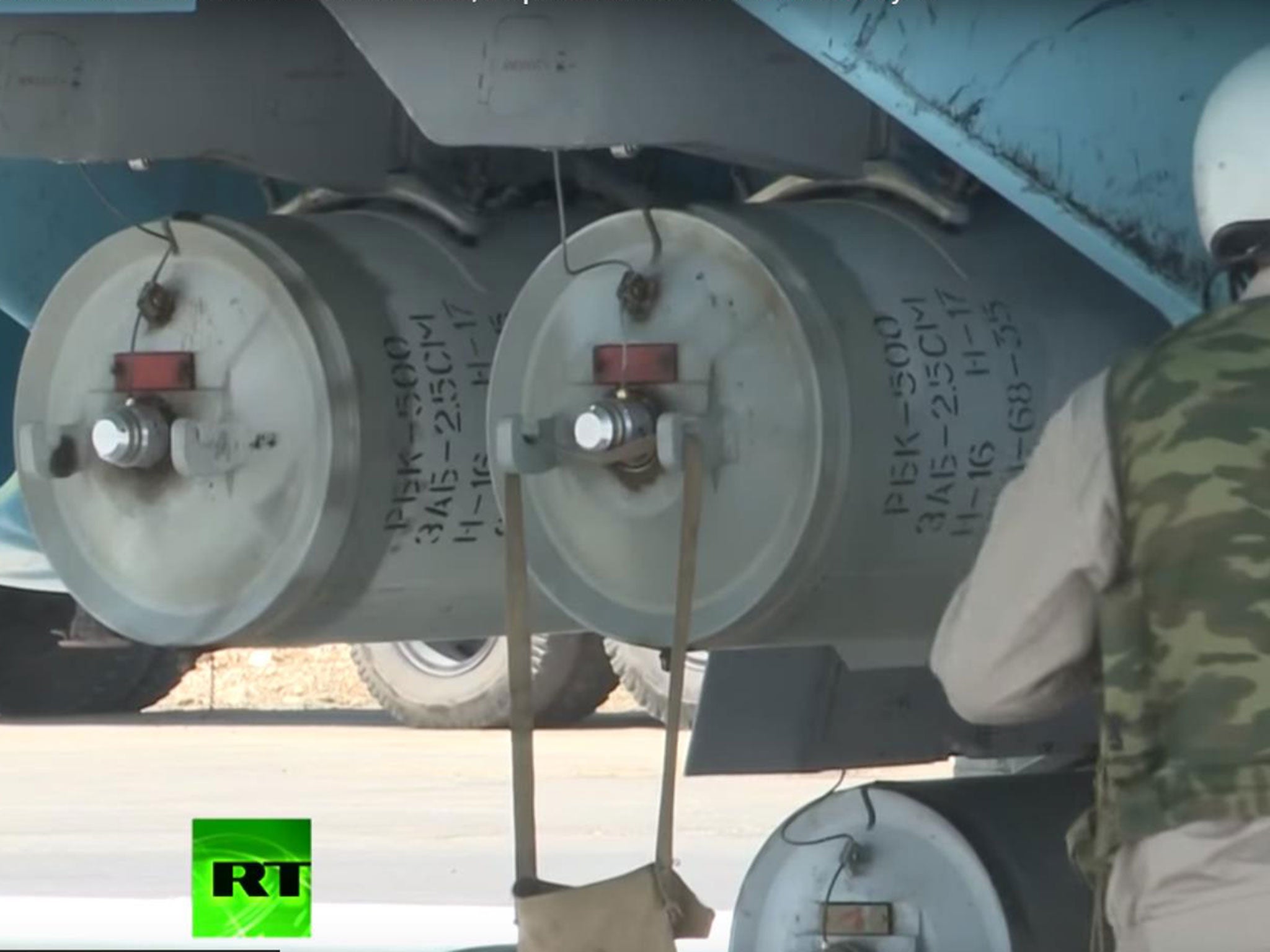Russia-backed broadcaster RT cuts footage proving use of incendiary ‘cluster bombs’ in Syria
Russia Today later reinstated the clip, saying it had been removed over concerns for a pilot

Russia Today has been accused of censoring footage of Russian jets in Syria to cover up the use of incendiary "cluster bombs".
Footage broadcast from Khmeimim airbase on Saturday appeared to show a plane loaded with munitions of a similar type that were dropped on US-backed rebels last week.
The four-second clip, included in a package on Russian defence minister Sergei Shoigu meeting Bashar al-Assad, shows bombs marked RBK-500 ZAB 2.5SM on a Su-34 jet.
Analysts from the Conflict Intelligence Team swiftly identified them as "cluster bombs", which the Russian defence ministry has repeatedly denied using in the face of mounting evidence, and accused Russia Today’ (RT) of "covering up war crimes".
The metal shell contains incendiary submunitions, which ignite while falling but are not defined as cluster bombs under international law as they do not contain explosives.
After the findings were published online, the relevant clip was cut from footage on YouTube, but was later restored following news reports and discussion on social media.
An editorial note below the video made no mention of the weapon, saying the frame had been removed over "concern for personnel safety" because of the pilot’s close-up, although he had his back to the camera.
"Upon re-evaluation it was deemed that the frame did not pose any risks; it had since been restored and the video is up in its original cut," the RT statement said.
Evidence has previously been found of RBK-500 bombs - which can carry either explosive or incendiary submunitions - being dropped by Russian forces in the rebel-held town of Maaret-al-Nouman, in Binin and elsewhere in the country's civil war.
The use of cluster munitions has been banned by more than 100 countries because of the widespread and indiscriminate damage they cause, dropping “bomblets” over wide areas that can fail to explode and become a long-term threat to civilians.
In pictures: Russian air strikes in Syria
Show all 19Russia and Syria are not party to a UN convention banning cluster bombs but signed another agreement on “excessively injurious or indiscriminate” weapons, which prohibits their use in civilian or residential areas.
The US also refused to ban the munitions, claiming eliminating its stockpiles would "put the lives of its soldiers and those of its coalition partners at risk", while British-made cluster bombs have been found after Saudi-led strikes in Yemen.
Mary Wareham, the advocacy director at Human Rights Watch's arms division, told The Independent the use of incendiary munitions like the RBK-500 ZAB 2.5SM can also be illegal.
"The UN convention prohibits dropping incendiary weapons on civilian areas and that's what appears to by happening in Syria," she added.
The Syrian Observatory for Human Rights published photos appearing to show the tail section of an RBK-500 cluster bomb at a camp for the coalition-backed New Syrian Army, where several fighters had been killed in an air raid on Thursday.
The attack in al-Tanf, where rebel groups armed and trained by the US-led coalition are fighting Isis, sparked a new diplomatic row between Washington and Moscow amid continuing division over Vladimir Putin’s support for the Assad regime.
Peter Cook, the Pentagon press secretary, said Russian and American officials held a video conference on Saturday to avoid "accidents and misunderstandings" as both nations continue their air campaigns.
He said that Russia had disregarded US attempts to inform the air force "through proper channels" that its targets were part of anti-Isis forces and part of a truce, with Russian planes reportedly bombing the air base after American jets approached in an attempt to contact pilots.
Russian defence ministry claimed the base it targeted was "more than 300km away" from territory controlled by opposition groups covered by the cessation of hostilities.
"The American party has not presented coordinates of regions of activity of opposition controlled by the US," a statement said. "This caused impossibility to correct actions of the Russian aviation."
Amnesty International and Human Rights Watch are among the groups criticising Russia’s deployment of cluster bombs, noting a surge in their appearance in Syria since it joined the conflict in September.
An Amnesty International report recorded evidence of civilian casualties, saying the use of the "inherently indiscriminate" weapons in densely populated areas violated international law.
In response to the claims, Russia’s defence ministry spokesperson hit out at "fakes and clichés" and issued a denial.
"Russian aircraft in Syria do not use cluster munitions and such weapons are not stored at the Hmeymim air base," Major General Igor Konashenkov was quoted as saying in December.
Russian jets and bombers have been flying out of the base, in regime-held Latakia province, since Putin launched the campaign to support the Assad regime in September.
Subscribe to Independent Premium to bookmark this article
Want to bookmark your favourite articles and stories to read or reference later? Start your Independent Premium subscription today.

Join our commenting forum
Join thought-provoking conversations, follow other Independent readers and see their replies